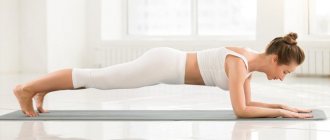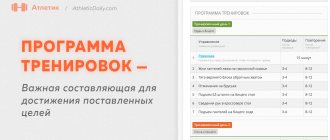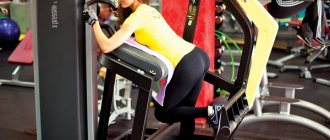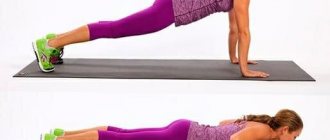What is strength training for?
Strength training (anaerobic training) is a set of exercises aimed at developing and strengthening muscle mass, changing body shape and correcting figure flaws. Strength exercises allow you to build muscles, work out their silhouette, improving the appearance of your body.
Anaerobic exercises are performed with weights. Exercise equipment and free weights are used as weights - dumbbells, barbells, kettlebells, weights, elastic bands. The working weight is selected individually depending on the training plan and physical fitness of the athlete.
Strength training in combination with aerobic exercise allows you to change metabolic processes, helping to fight the “plateau” in weight loss and achieve effective weight loss with long-term results.
Schedule
In professional sports, training takes up most of the time and the daily routine is scheduled minute by minute for months in advance.
Special schedules are drawn up for athletes - cycles, according to which they, for example, prepare for the Olympics or other competitions. Any deviation may result in failure to achieve the desired results. In fitness, everything is simpler; a person comes to workout in his free time and whenever he wishes. And if he wants to take a break, then he won’t endure any problems from it. So, now you and I know that fitness is more gentle physical activity that is aimed at maintaining and strengthening health. For fitness, it is enough to engage in feasible physical activity at any convenient time and eat right. And sport is a professional activity that is associated with a focus on: achieving sports results, winning competitions, setting records; These are prohibitive loads for the body, the risk of injury, a strict diet and daily routine. Fitness is like a part of life. And sport for a person becomes his whole life. [ratings] (Visited 102 times, 4 visits today)
Strength training in a group
This type of strength training is suitable for those who want to effectively work out all major or individual muscle groups in a short time. The duration of the classes does not exceed 40-50 minutes, the pace of the exercises is set by the instructor. The benefits of strength training in a group include team spirit and a competitive element as additional motivation for lazy athletes.
Most popular destinations:
- Body Pump, Shock, Sculpt – a strength exercise to work the muscles of the whole body. Performed with various free weights under the guidance of an instructor and accompanied by music.
- ABS, ABL, Lower and Upper Body – strength training for working individual muscle groups (abdomen, arms, legs, buttocks, etc.)
- Interval Training is a workout that alternates cycles of aerobic and anaerobic exercise. The duration of the cycle is set by the instructor. Interval training allows you to speed up the fat burning process and tighten your body muscles.
Main types of group classes, their characteristics
All types of training can be divided into several groups:
- cardio training using your body weight;
- power, giving relief;
- intelligent body";
- with elements of martial arts;
- with dance elements.
Cardio training
What it is? To put it simply, these are activities that speed up our pulse. The simplest and most accessible cardio workouts are running, cycling, and swimming. In a sports club these include:
- step;
- classical aerobics;
- interval training;
- slide aerobics;
- functional training.
These classes are held at a brisk pace with rhythmic music. The result of such training will be improved functioning of the cardiovascular system and active fat burning.
Cardio training is the best option for losing weight. These types of activities are not recommended for people suffering from severe diseases of the cardiovascular system, asthmatics, diabetics and cancer patients.
Power training
You can exercise with weights not only in the gym. There are many group programs that involve the active inclusion of barbells (body bars), dumbbells, and weights for arms and legs. Most often this is a light weight, and the effect is achieved through a large number of repetitions of each exercise.
These power classes include:
- body sculpt;
- ABT+Flex;
- Upper body;
- crossfit;
- Body Pump.
Such workouts are suitable for various levels of training; beginners just use less weight.
The result of strength training will be not only getting rid of excess weight, but also the appearance of a beautiful relief, without excess muscle mass. There are practically no contraindications to performing strength training; you just need to correctly dose the load on the muscles.
Reasonable body Body&Mind
Classes in this format are aimed at developing the ability to listen to your body. Calm movements combined with certain breathing, static poses, concentration on sensations - all this is about Body&Mind. During these workouts, flexibility and endurance develop, posture improves, stress and tension are relieved. There will be no immediate results, but with regular attendance at such classes, excess weight will go away and the body will become healthier.
Main types of “mind body” activities:
- yoga;
- stretching;
- Pilates;
- bodyflex;
- callanetics.
These relaxing workouts are popular among residents of big cities who want to relieve tension after a hard day at work. They are suitable for all ages and all fitness levels.
Training with elements of martial arts
Such activities are not very suitable for beginners, as they require a certain strength and endurance. The classes are based on aerobics, complemented by various specific movements:
- fit-bo - karate;
- tai-bo – boxing and taekwondo;
- ki-bo – kickboxing.
Such exercises can be recommended for those who have little or no excess weight. Also, good stretching and coordination will not be superfluous. Training with elements of martial arts helps to release aggression and accumulated stress.
Dance workouts
This is perhaps one of the most enjoyable types of fitness activities. Essentially, this is the same cardio training, only with elements of different dance styles:
- Latin;
- Eastern dance;
- Zumba;
- hip-hop;
- strip dance;
- body ballet;
- ort de bras.
In this segment of training, the choice is truly huge, where everyone can choose a dance to their liking. By mastering new dance steps, you simultaneously develop flexibility, endurance and lose excess weight. Dancing classes are also very effective for losing weight, giving a huge boost of energy and good mood.
Individual strength training
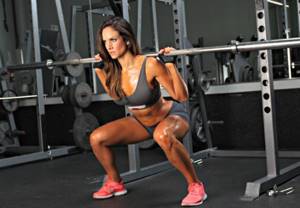
Athletes who, for one reason or another, do not want to train in a group can choose individual training. Exercises are performed in the gym or at home using machines or free weights. The athlete chooses the sequence of exercises, pace and weight independently.
The effectiveness of strength training largely depends on the technique of performing the exercises. Incorrect positioning of the body, jerking, and incorrect amplitude can reduce performance to a minimum, and in some cases lead to serious injuries. Individual lessons with an experienced instructor have obvious benefits for beginners and athletes who are unsure of their technique.
There are various methods of individual strength training:
- Full Body – all major muscle groups are worked out in one workout;
- Split – strength loads are given to separate muscle groups on different days;
- Interval Training – alternating aerobic and anaerobic exercise during one workout.
Duration and frequency of strength training
During strength training, micro-traumas to the muscles occur, and the body needs time to recover. Experts recommend that beginners avoid overly intense exercise and include strength training every other day, alternating it with rest days or cardio training. The same option is suitable for Full Body training. In Split programs, the muscle groups being worked alternate with each other on different days.
A workout is considered effective if its duration does not exceed 1 hour. Experts believe that this time is enough to work out the necessary muscles and start the fat burning process.
Features of women's training

Strength training for women has some features due to metabolism, the distribution of fat and muscle mass, the hormonal system, and the presence of the menstrual cycle.
The opinion that by training with heavy weights you can get a masculine figure is wrong. The female body produces tens of times less of the hormone testosterone, which is responsible for muscle growth, so women should not be afraid of strength training.
The most effective workout for losing weight is long-term aerobic exercise while keeping your heart rate (heart rate) level at the lower limit. Women are advised to avoid interval training.
The menstrual cycle also dictates its own rules. If your health allows, then training at the beginning of the cycle will be most effective. After the ovulation period, the female body begins to accumulate energy to bear offspring, and intensive training does not make sense.
Women are recommended to work on the upper muscles (back, biceps, triceps), high-repetition training of the legs and buttocks, a balanced diet with calorie counting and regular aerobic exercise.
Weight loss workouts

Weight loss occurs when more calories are consumed than consumed, so the main percentage of success depends on properly organized nutrition. Strength training, unlike cardio, allows you not only to burn calories, but also to maintain muscle mass. The principles behind strength training for fat loss are:
- Increasing the number of repetitions and reducing working weight.
- Reduce rest between sets.
- Including sets and supersets in your training, when several exercises are performed one after another without rest between approaches.
- Increasing the number of workouts during the week.
- Adding 20-30 minutes of aerobic exercise after performing strength exercises.
Popular women's workouts
Aerobics is dance fitness, the purpose of which is to stimulate the cardiovascular system, actively lose weight and improve the overall health of the body. Aerobics classes are perfect for those who lead a sedentary lifestyle and have an average (low) level of athletic training.
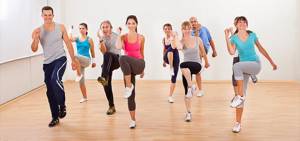
Today there are about 40 types of aerobics, most of which can be done both in the gym and at home. The most popular types of fitness training are:
- Gymnastics and athletics classes (stretching, classical aerobics classes);
- Various dance styles (salsa, zumba, jazz);
- Cyclic training (step, cycle).
In addition to aerobics, there are other alternative exercise options. One of them is bodyflex - a set of specially selected breathing exercises, the main goal of which is active fat burning. Regular training also allows you to strengthen your muscles and restore their lost tone.

All exercises that are part of the bodyflex complex are divided into three main groups:
- Isotonic (they work several or even all muscle groups);
- Isometric (works one muscle group);
- Stretching exercises (relieve the load on ligaments and muscle fibers, making them more elastic).
Bodyflex is great for regular exercise (4-5 times a week) at home.
Shaping is dance gymnastics for figure correction. Great for women aged 30 to 50 years. The basis of this type of fitness is the precise sequential implementation of a set of special exercises.
Shaping classes involve achieving two main effects:
- Anabolic (muscles acquire the necessary shape, increase in volume - the result is provided by strength exercises);
- Catabolic (reduction of body fat due to cardio exercise).
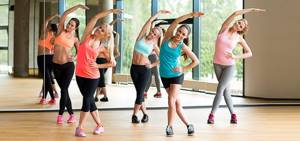
It is recommended to do shaping in the gym, under the supervision of a trainer, but if this is not possible, the exercises can be performed at home.
